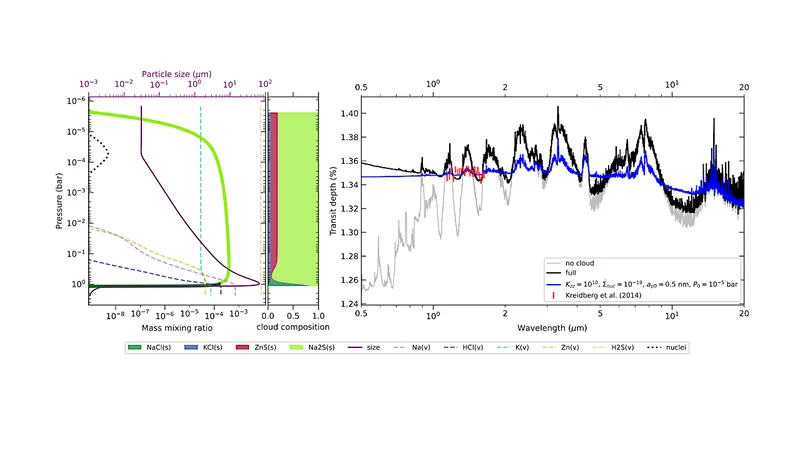
Revolutionary Cloud Modeling Breakthrough in Exoplanet Atmospheric Studies
2024-10-01
Introduction
In the realm of exoplanet research, clouds are omnipresent, serving a pivotal role in determining the opacity and chemical makeup of these distant atmospheres. Gaining insights into cloud formation is critical for deciphering spectroscopic data, which can unveil the atmospheric conditions existing on faraway worlds.
ExoLyn: A New Cloud Model
The cutting-edge research aims to model the multi-species complexity of clouds through atmospheric retrieval studies. Enter ExoLyn - a one-dimensional cloud model ingeniously designed to strike a balance between physical realism and computational speed. Developed with innovative methods, ExoLyn accurately solves the transport equations for cloud particles and vapor, featuring self-consistent cloud condensation rates derived from thermodynamic principles.
Integration and Utility
What sets ExoLyn apart is its capability as a standalone open-source package which can seamlessly integrate with existing tools like optool for solid opacity calculations, and RADTRANS for the generation of transmission or emission spectra. This integration maximizes its utility for atmospheric studies and enhances the accuracy of exoplanetary analyses.
Results and Insights
Results from ExoLyn have revealed fascinating insights into the atmospheric cloud structures of hot Jupiter planets. For instance, the modeling indicates a stratified cloud formation; a layer predominantly composed of magnesium silicates overlays an iron cloud layer. Such findings echo those from more intricate cloud formation models. However, ExoLyn is capable of delivering these results in mere seconds, showcasing its efficiency.
Spectral Discoveries
The spectral data derived from the cloud composition has led to intriguing discoveries; certain components like MgSiO3 and Mg2SiO4 introduce distinctive absorption features in spectral data between 8-10 micrometers. Furthermore, remarkable dependencies have been observed where SiO2-rich clouds are generated on metal-rich exoplanets, while iron-rich clouds featuring strong extinction effects correspond to carbon-rich environments.
Versatility of ExoLyn
Designed for versatility, ExoLyn also proves to be an excellent tool for retrieving atmospheric analyses of sub-Neptunes and self-luminous planets, paving the way for joint retrievals of gases and cloud components. This breakthrough in cloud modeling not only enhances our understanding of exoplanetary atmospheres but could also revolutionize how astronomers interpret distant worlds.
Conclusion
In a time where exploration of exoplanets is more pressing than ever, tools like ExoLyn can bring us closer to unraveling the mysteries of the universe. As scientists continue to probe the atmospheres of these celestial bodies, we may soon unlock answers that could redefine our understanding of the cosmos.
Further Reading
For more information on this groundbreaking study and its implications for astrobiology, explore the detailed findings from leading researchers Helong Huang, Chris W. Ormel, and Michiel Min, who are pushing the boundaries of exoplanetary science.


 Brasil (PT)
Brasil (PT)
 Canada (EN)
Canada (EN)
 Chile (ES)
Chile (ES)
 España (ES)
España (ES)
 France (FR)
France (FR)
 Hong Kong (EN)
Hong Kong (EN)
 Italia (IT)
Italia (IT)
 日本 (JA)
日本 (JA)
 Magyarország (HU)
Magyarország (HU)
 Norge (NO)
Norge (NO)
 Polska (PL)
Polska (PL)
 Schweiz (DE)
Schweiz (DE)
 Singapore (EN)
Singapore (EN)
 Sverige (SV)
Sverige (SV)
 Suomi (FI)
Suomi (FI)
 Türkiye (TR)
Türkiye (TR)